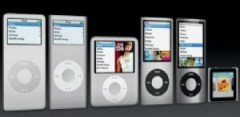If you look at the iPod Nano through the years, it’s hard to tell what Apple wants the product to be.
Apple has reinvented the diminutive music (and sometimes video) player on a nearly annual basis, swinging it from tall and skinny to short and stout, adding and removing cameras and flirting with apps. None of these changes gave the Nano much direction, and it’s always floated in an awkward middle ground between the budget iPod Shuffle, the capacity-laden iPod Classic and the powerhouse iPod Touch.
(MORE: Apple Rolls Out ‘Maximum Funness’ iPod Touch, Revamps iPod Nano Line)
That all changed in 2010, when Apple introduced the sixth-generation iPod Nano, a tiny square with a touch screen and an iOS-like set of built-in apps. I don’t know how well it sold–Apple doesn’t break down iPod sales by model–but the concept was exciting. Accessory makers sold wristbands that turned the Nano into a watch, and armbands that made them ideal for workouts. Apple even rolled with the idea and added new watchfaces and a workout tracker to the Nano in 2011.

Apple
But this year, Apple is rebooting the Nano again. The product has transformed into a credit-card-sized, feature-crippled iPod Touch, with a handful of built-in apps (and inexplicably ugly circular icons), a hardware home button and the ability to play videos. It’s definitely too large to be wearable.
Maybe in the short term, a super-sized Nano is the right call for maximum sales. But by nixing the wearable Nano, Apple is missing out on an opportunity to experiment. Just as the company considers the Apple TV to be a “hobby” with big potential, the smaller iPod Nano could have been a chance to learn about wearable computers.
(MORE: Would Apple Create a Smartwatch? If So, When?)
The idea of wearable tech is starting to gather steam. Smart watches such as the Pebble will allow users to keep an eye on their digital lives even while their phones are stowed away. Google is working on computerized eyeglasses, which can augment reality and keep important information in view. Hackers are starting to implant simple hardware under their skin.
Although Apple’s wearable iPod Nano wasn’t as ambitious as those ideas, it had the right building blocks. The software was smooth and responsive. The hardware was small enough to look sensible on the wrist. Prices were already reasonable, and unlike small projects such as Pebble, Apple’s Nano was already mass-produced and highly visible to consumers.
As Tim Bajarin pointed out last April, the next step for Apple could have been to add a Bluetooth connection to the Nano, allowing it to show incoming messages, news alerts and more from a paired smartphone. Instead, Apple only added basic Bluetooth functionality for wireless audio and went back to pitching the Nano as a small music and video player.
I want to be optimistic that Apple hasn’t written off wearable computing. Maybe the company learned some things from the Nano and is now going back to the lab to work on something better. But I’m saddened to see that even if Apple has interest in the concept, it’s no longer toying with it out in the open.
Related iPhone 5 Coverage:
- Apple’s iPhone 5: A Thinner, Lighter, Taller 4G Phone
- Scenes from Apple’s iPhone 5 Announcement
- iOS 6 Here Next Week, New iTunes in October
- Apple Rolls Out ‘Maximum Funness’ iPod Touch, Revamps iPod Nano Line
- Video: 5 Reasons to Buy the iPhone 5
- Will Apple’s iPhone 5 Revolutionize Mobile Gaming with ‘Console Quality’ Graphics? Not Likely
- Live Coverage: Apple’s iPhone 5 Event
- Ask Techland: Best Places to Sell an Old iPhone or Trade for Store Credit?

